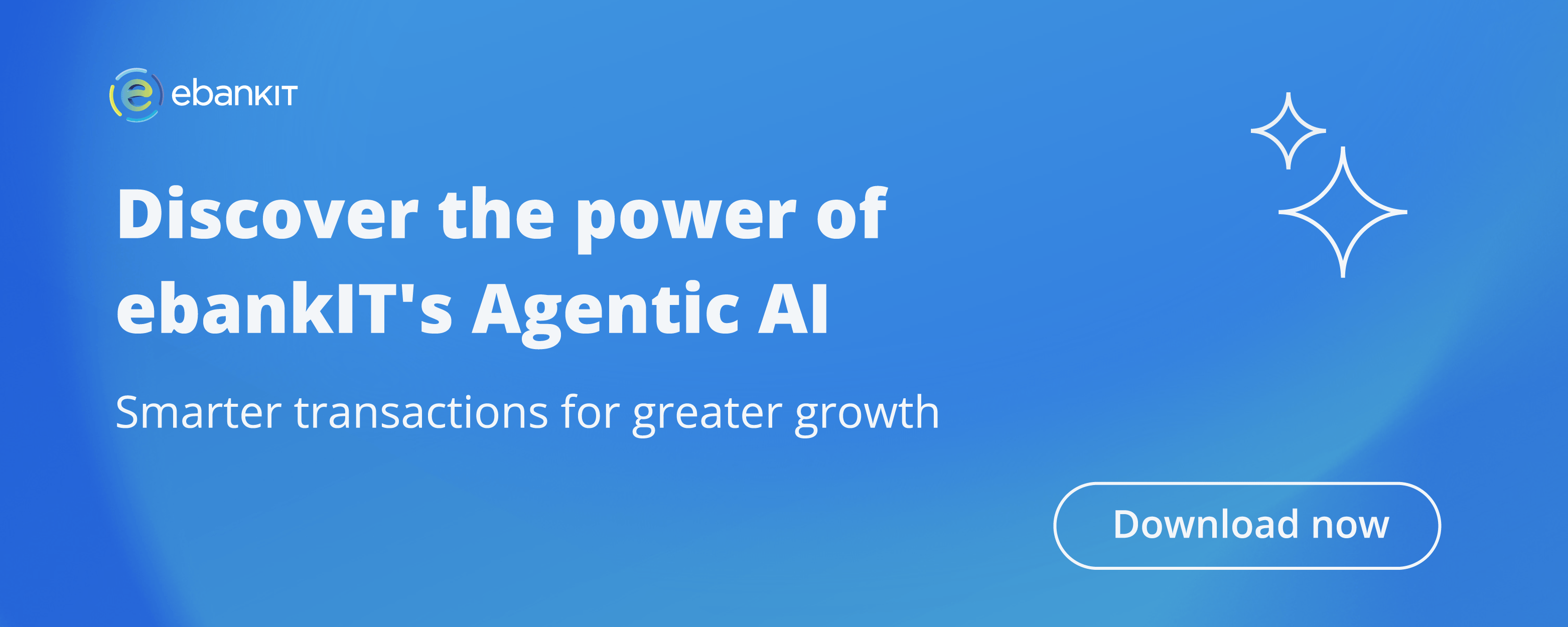Executive summary
- ebankIT is revolutionizing conversational banking, enabling real banking tasks like transfers and spending analysis.
- An AI 2.0 that delivers insights based on users’ financial behavior, marking a shift from reactive to intelligent, context-aware banking.
- It supports business-level governance, such as tracking user activity and managing account access, cash flow analysis, etc..
-
ebankIT has prebuilt connectors that allow the agentic AI to overlay existing core banking systems securely via APIs, avoiding disruptive changes.
Paul Provenzano, VP of Market Development at ebankIT, was the guest of the State of FinTech podcast hosted by Destinee Day from York Publications, where he shared insights into how this next-gen AI is changing the game.
With decades of experience in digital strategy and technology implementation, Provenzano offered a candid look at both the opportunities and challenges that come with AI-driven transformation.
AI 2.0 - The next generation of Artificial Intelligence
ebankIT made waves at FinovateFall with its latest innovation, its Agentic banking AI, a conversational banking assistant that’s redefining how customers interact with their financial institutions.
While most banking chatbots offer scripted responses and limited functionality, ebankIT’s Agentic AI marks a significant leap forward. Provenzano explained that this assistant is deeply integrated with core banking systems, enabling users to perform real financial tasks such as money transfers, card controls, and spending analysis, all based on their personal financial data.
It’s deeply integrated with core banking systems, allowing users to perform real banking tasks such as transfers, card controls, and spending analysis, based on their personal financial data. “It creates a much more personalized experience for each individual user,” says Paul Provenzano on the podcast.
It creates a much more personalized experience for each individual user,” Provenzano said, highlighting the assistant’s ability to tailor interactions to each customer’s unique financial behavior.
This marks the shift to AI 2.0 in banking, where the assistant is not just reactive but proactively delivers insights tailored to each user’s financial behavior.
Shift from menu-based to conversational banking
As traditional branch-based banking relationships fade, consumers are increasingly turning to mobile and digital platforms for more personalized financial experiences. Provenzano discussed how the company’s Agentic Banking AI is meeting this demand head-on.
Unlike generic chatbots that offer one-size-fits-all responses, ebankIT’s Agentic AI tailors its answers based on each user’s transactional history and financial relationship with their institution. This context-aware approach ensures that users receive individualized insights and support, making digital banking feel more like a personal conversation than a tech interaction.
He mentions that traditional banking interfaces often require users to navigate multiple screens and menus. Agentic AI simplifies this by enabling a natural, conversational experience, allowing users to ask for information or initiate actions, such as transfers or card controls, just as they would with a voice assistant in their daily lives.
The spectrum of capabilities is quite broad and extensive,” Provenzano noted, emphasizing the assistant’s versatility across use cases.
Powered by Microsoft Azure, Agentic AI combines robust cloud infrastructure with advanced natural language processing to deliver a smooth, secure, and scalable experience. Provenzano highlighted that the assistant feels less like interacting with a tech provider and more like speaking directly with your bank, a key differentiator in today’s digital-first landscape.
ebankIT’s AI tool offers not only multilingual support without additional language conversion investments but also provides a wide range of capabilities:
- Mortgage Simulation: AI can calculate affordability based on deposit history and expenses.
- Spending Insights: Detects redundant subscriptions or spending habits and suggests savings.
- Fraud Detection: Identifies suspicious transactions and enables immediate card locking 24/7.
- Service Cost Tracking: Users can prompt AI to find which service providers have increased costs over time.
ebankIT's AI also supports business-level governance, such as tracking user activity and managing account access. For small businesses, it offers powerful tools like:
-
- Cash flow analysis (e.g., comparing current vs. past periods).
- Expense categorization and visualization.
- Service provider trend tracking.
These insights are generated quickly through simple prompts, eliminating the need for manual data handling.
Impact on Customer Experience
Agentic AI functions as a 24/7 intelligent banking assistant, offering immediate, personalized support by understanding each user’s unique financial profile. More than just answering simple queries, it leverages broader consumer trends and behavioral data to deliver sophisticated, actionable insights.
By enabling users to engage with their financial wellness in a proactive and intuitive way, Agentic AI transforms banking from a transactional experience into a dynamic, ongoing conversation. Built to mirror the natural flow of human interaction, it empowers users to manage their finances with ease and confidence, anytime, anywhere.
Watch the full podcast episode now
Seamless integration with legacy systems
ebankIT’s platform is API-first, cloud-native, ensuring fast, secure performance. At its core is the Model Context Protocol (MCP), a “universal translator” that allows AI to interact seamlessly with banking systems, including payments, compliance, and customer data, while maintaining context across multiple transactions without requiring repeated authentication.
A standout feature is its integration layer, which includes prebuilt connectors, enabling seamless interfacing with any core banking system or middleware, whether for consumer, commercial, or mortgage services.
This means no disruptive infrastructure changes. The agentic AI simply overlays existing systems, securely accessing and interacting with data via APIs.
Balancing conversational flexibility with security
For financial institutions, compliance and user empowerment are non-negotiable,” said Paul Provenzano. “At ebankIT, we have built our Agentic AI with security at its core, from robust authentication and full encryption to detailed activity logging. Every interaction happens within a secure login environment, ensuring data protection is never compromised.
He went on to explain that clear operational boundaries are in place to safeguard both users and institutions, especially for tasks that require human judgment. “We’re very intentional about how far AI should go. It is not about replacing people, it is about enhancing the experience while staying within safe, responsible limits.”
Provenzano also emphasized the importance of a stepwise approach to AI adoption. “We always recommend starting with support-oriented use cases, things like FAQs, account inquiries, and basic transactions. Once that foundation is solid, institutions can scale up to more advanced capabilities with confidence.”
Looking ahead: the future of agentic AI
Provenzano highlights that, over the next 2–3 years, there will be a significant shift in digital banking interfaces. Instead of navigating menus and pages, users will engage through prompts and proactive insights.
Imagine logging in and being greeted with personalized suggestions like allocating a recent salary increase toward savings or mortgage payments.
This evolution turns digital banking into a relationship-driven experience, where AI anticipates needs and supports financial wellness.
Paul emphasizes that AI is not here to replace humans but is designed to empower them. By automating repetitive tasks, employees can focus on strategic roles such as financial advising, investment planning, and customer relationship management. It’s a win-win for efficiency and customer satisfaction.





%20without%20SAM%20-%20Maturity%20Level%20-%202-KO%20edit.webp?width=160&height=57&name=67768-ebankIT%20Platform%20-%20CMMI%20Development%20V2.0%20(CMMI-DEV)%20without%20SAM%20-%20Maturity%20Level%20-%202-KO%20edit.webp)
